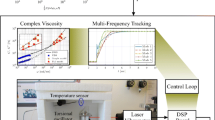Abstract
A new device for measuring the rheological properties of soft biological tissues is presented. The mechanical response is characterized for harmonic shear deformations at high frequencies (up to 10 kHz) and small strains (up to 0.2%). Experiments are performed using a cylindrical rod excited to torsional resonance. One extremity of the rod is in contact with the soft tissue and adherence is ensured by vacuum clamping. The damping characteristics and the resonance frequency of the vibrating system are inferred from the control variables of a phase stabilization loop. Due to the contact with the soft tissue, and depending on the rheological properties of the tissue, changes occur in the Q-factor and in the resonance frequency of the system. The shear modulus of the soft tissue is determined from the experimental results with an analytical model. The reliability of the proposed technique is evaluated through repeatability tests and comparative measurements with synthetic materials. The results of measurements on bovine organs demonstrate the suitability of the experimental procedure for the characterization of biological tissues and provide some insight in their rheological properties at frequencies in the range 1–10 kHz.





















Similar content being viewed by others
References
Abramowitz M, Stegun IA (1972) Handbook of mathematical functions with formulas, graphs, and mathematical tables. Dover Publications, New York
Arbogast KB, Thibaut KL, Scott Pinheiro B, Winey KI (1997) A high frequency shear device for testing soft biological tissues. J Biomech 30:757–759
Avis NJ (2000) Virtual environment technologies. Minim Invasive Ther 9:333–340
Bert CW (1973) Material damping: and introductory review of mathematical models, measures and experimental techniques. J Sound Vib 29:129–153
Bishop RED, Johnson DC (1979) The mechanics of vibration. Cambridge University Press, Cambridge
Carter FJ, Frank TG, Davies PJ, McLean D, Cuschieri A (2001) Measurement and modelling of the compliance of human and porcine organs. Med Image Anal 5:231–236
Dorn GA (1980) Radiation impedance and radiation patterns of torsionally vibrating seismic sources. PhD Thesis, University of California, Berkeley
Gladwell GML (1980) Contact problems in the classical theory of elasticity. Sijthoff and Noordhoff, Alphen aan den Rijn Germantown - Md
Graf KF (1991) Wave motion in elastic solids. Dover Publications, New York
Greenleaf JF, Fatemi M, Insana M (2003) Selected methods for imaging elastic properties of biological tissues. Annu Rev Biomed Eng 5:57–78
Hendriks FM, Brokken D, van Eemeren J, Oomens CWJ, Baaijens FPT, Horsten JBAM (2003) A numerical-experimental method to characterize the non-linear mechanical behaviour of human skin. Skin Res Tech 9:274–283
Kalanovic D, Ottensmeyer MP, Gross J, Gerhardt B, Dawson SL (2003) Independent testing of soft tissue viscoelasticity using indention and rotary shear deformation. Medicine Meets Virtual Reality, vol 11. IOS Press, pp 137–143
Kauer M, Vuskovic V, Dual J, Szekely G, Bajka M (2002) Inverse finite element characterization of soft tissues. Med Image Anal 6:275–287
Kruse SA, Smith JA, Lawrence AJ, Dresner MA, Manduca A, Greenleaf JF, Ehman RL (2000) Tissue characterization using magnetic resonance elastography: preliminary results. Phys Med Biol 45:1579–1590
Liu Z, Bilston LE (2000) On the viscoelastic character of liver tissue: experiments and modelling of the linear behavior. Biorheology 37:191–201
Manduca A, Oliphant TE, Dresner MA, Mahowald JL, Kruse SA, Amromin E, Felmlee JP, Greenleaf JF, Ehman RL (2001) Magnetic resonance elastography: non-invasive mapping of tissue elasticity. Med Image Anal 5:237–254
Miller K, Chinzei K, Orssengo G, Bednarz P (2000) Mechanical properties of brain tissue in vivo: experiment and computer simulation. J Biomech 33:1369–1376
Nasseri S, Bilston LE, Phan-Thien N (2002) Viscoelastic properties of pig kidney in shear, experimental results and modeling. Rheol Acta 41:180–192
Nava A, Valtorta D, Mazza E (2003) Experimental determination of the mechanical properties of soft biological tissues. In: Proceedings of the 9th international conference on the mechanical behaviour of materials, Geneva
Nava A, Mazza E, Kleinermann F, Avis NJ, McClure J, Bajka M (2004) Evaluation of the mechanical properties of human liver and kidney through aspiration experiments. Technol Health Care 12:269–280
Ottensmeyer MP (2002) TeMPeST 1-D: an instrument for measuring solid organ soft tissue Properties. Exp Tech 26:48–50
Picinbono G, Lombardo JC, Delingette H, Ayache N (2002) Improving realism of a surgery simulator: linear anisotropic elasticity, complex interactions and force extrapolation. J Visual Comp Animat 13:147–167
Robertson IA (1967) On a proposed determination of the shear modulus of an isotropic elastic half-space by forced torsional oscillations of a circular disc. Appl Sci Res 17:305–312
Romoscanu AI, Sayir MB, Häusler K, Burbidge AS (2003) High frequency parallel plate probe for the measurement of the complex viscosity of liquids. Rheol Acta 42:462–476
Sagoci HF (1944) Forced torsional oscillations of an elastic half-space II. J Appl Phys 15:655–662
Sayir M, Goodbread J, Häusler K, Dual J (1995) Method and device for measuring the characteristics of an oscillating system. Pat. Corp. Treat. PCT/EP95/00761
Sneddon IN (1966) The Reissner-Sagoci problem. Proc Glasgow Math Assoc 7:136–144
Snedeker JG, Bar-Bezat M, Niederer P, Schmidlin FR, Farshad M, Demetropoulos CK, Lee JB, Yang KH (2005) Strain-rate dependent material properties of the porcine and human kidney capsule. J Biomech 38:1011–1021
Szekely G (2003) Surgical simulators. Minim Invasive Ther 12:14–18
Treloar LRG (2005) Physics of rubber elasticity. Oxford University Press, Oxford
Zheng Y, Mak AFT (1996) An ultrasound indentation system for biomechanical properties assessment of soft tissues in vivo. IEEE Trans Biomed Eng 43:912–918
Acknowledgements
This work was supported by the Swiss NSF project Computer Aided and Image Guided Medical Interventions (NCCR CO-ME). We thank the company Kundert AG, Jona, Switzerland, for providing the elastomer samples.
Author information
Authors and Affiliations
Corresponding author
Rights and permissions
About this article
Cite this article
Valtorta, D., Mazza, E. Measurement of rheological properties of soft biological tissue with a novel torsional resonator device. Rheol Acta 45, 677–692 (2006). https://doi.org/10.1007/s00397-005-0026-6
Received:
Accepted:
Published:
Issue Date:
DOI: https://doi.org/10.1007/s00397-005-0026-6



